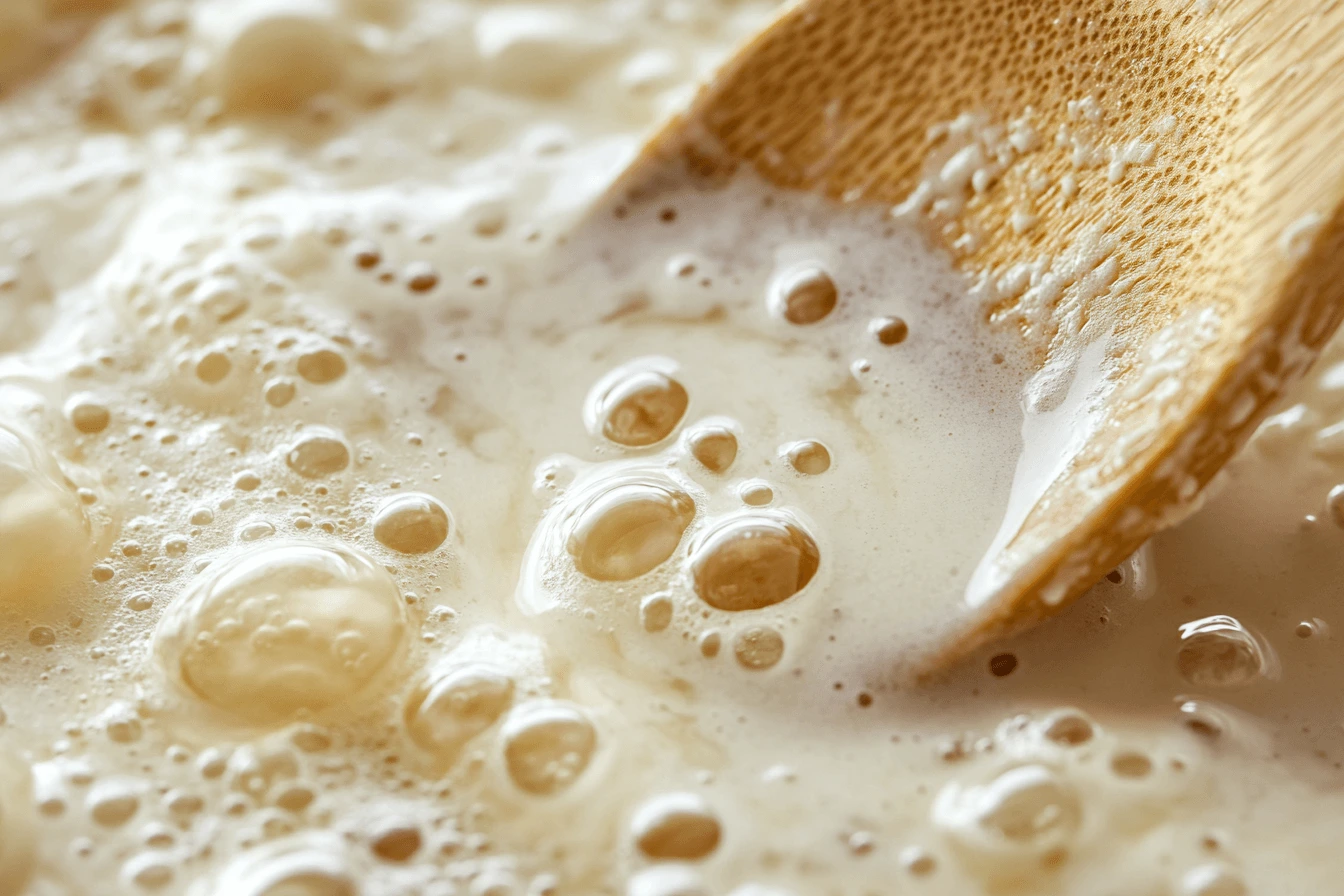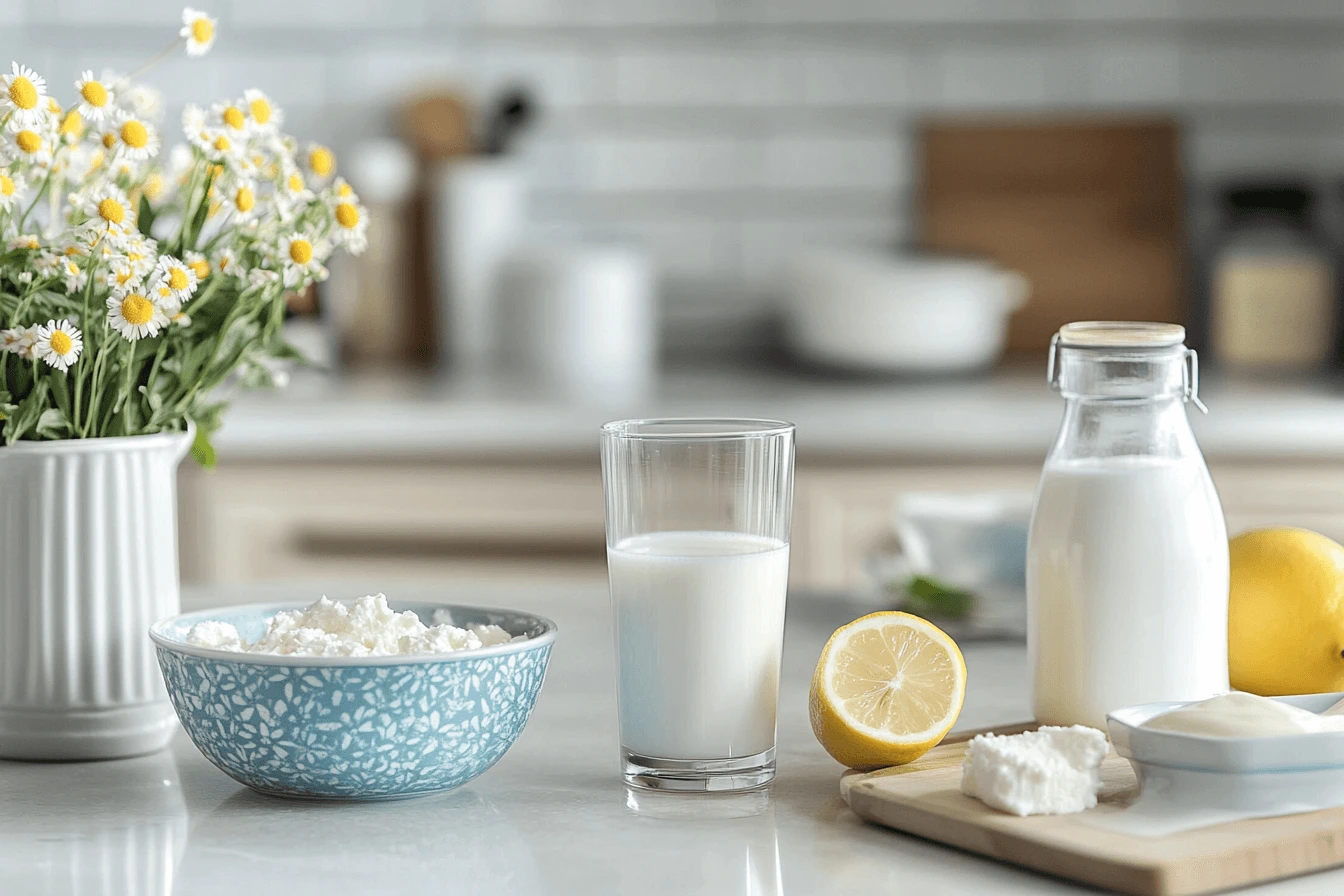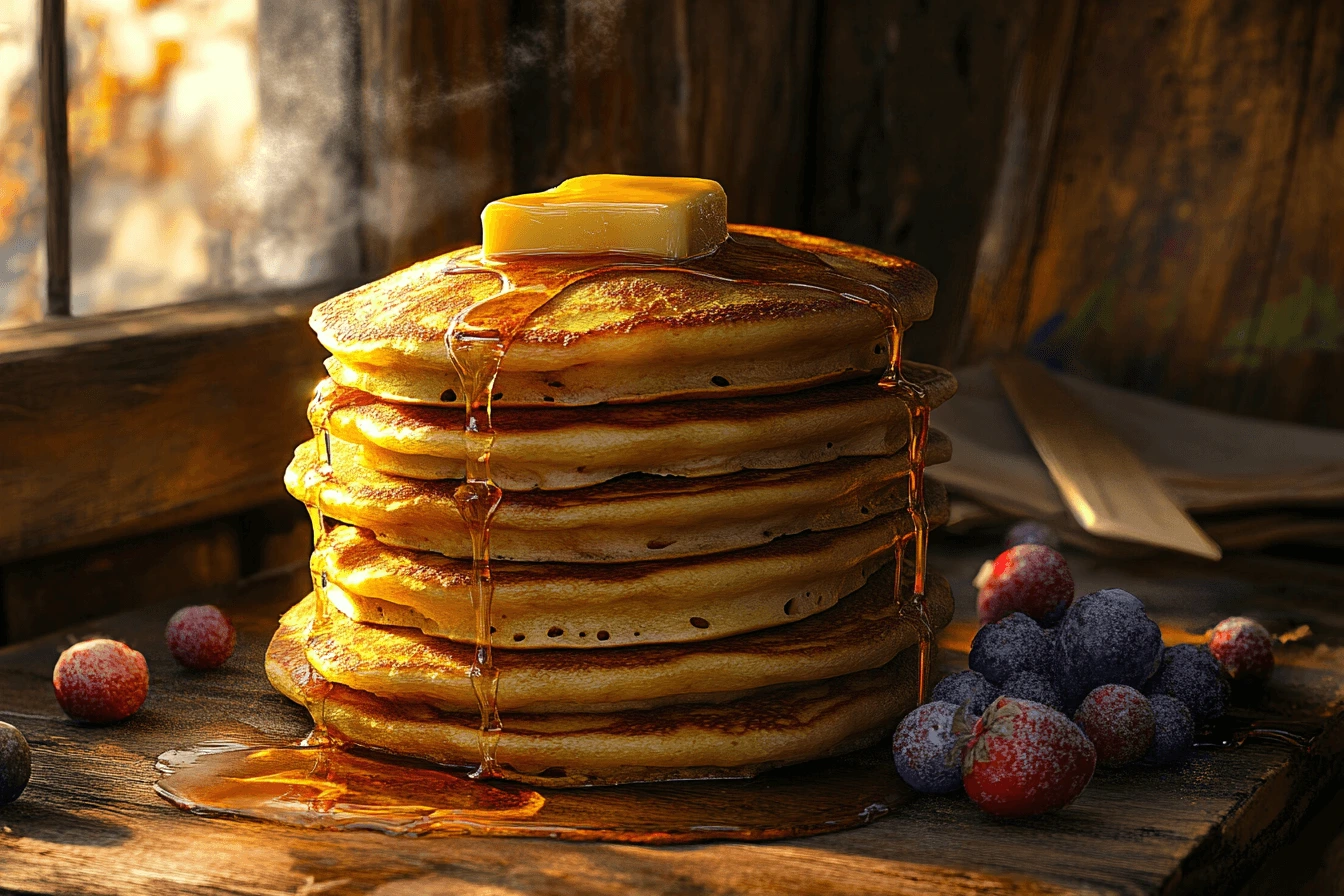Pancakes are a beloved breakfast staple worldwide. Whether you enjoy them light and fluffy or thick and hearty, the ingredients you use make all the difference. One ingredient that often appears in classic pancake recipes is buttermilk. But why do we put buttermilk in pancakes?
The answer lies in science, flavor, and texture. Buttermilk does more than just add moisture—it plays a crucial role in making pancakes fluffy, tender, and flavorful. It reacts with baking soda to create air bubbles, breaks down gluten for a softer texture, and adds a tangy taste that enhances the overall flavor.
In this article, we’ll explore the science behind buttermilk in pancakes, compare it with regular milk, discuss alternatives, and offer expert tips for making the best buttermilk pancakes. By the end, you’ll understand why buttermilk is a game-changer for perfect pancakes!
The Science Behind Buttermilk in Pancakes
At first glance, buttermilk might seem like just another liquid ingredient, but it has a unique chemical composition that makes it a key player in pancake recipes. The secret lies in its acidity.
Acid-Base Reaction in Baking
Buttermilk is slightly acidic, which means it reacts with baking soda to produce carbon dioxide gas. This gas creates tiny air bubbles in the batter, leading to light and fluffy pancakes. Without this reaction, pancakes would turn out dense and heavy.
The Role of Buttermilk in Gluten Development
Gluten is a protein found in flour that gives baked goods structure. While strong gluten networks are ideal for bread, they can make pancakes chewy instead of soft. The acid in buttermilk helps weaken gluten bonds, leading to a more tender bite.

How Buttermilk Affects Pancake Texture
One of the biggest reasons to use buttermilk in pancakes is texture. It makes a noticeable difference in how pancakes feel when you bite into them.
Tenderizing Gluten for a Softer Pancake
As mentioned earlier, buttermilk’s acidity helps soften the gluten strands in flour. This results in pancakes that are tender, rather than tough or chewy.
Moisture Retention
Buttermilk has a thicker consistency than regular milk, which means it adds more moisture to the batter. This ensures that your pancakes stay soft and delicious, even after they cool down.
Creating a Light and Airy Consistency
When combined with baking soda, buttermilk creates tiny air pockets throughout the pancake. These pockets expand as the pancakes cook, resulting in a fluffy texture.
How Buttermilk Affects Pancake Flavor
Beyond texture, buttermilk also enhances the flavor of pancakes in several ways.
Tangy, Slightly Sweet Taste
Buttermilk has a mild tanginess that balances the sweetness of pancakes. This contrast makes each bite more complex and satisfying.
Enhancing Other Ingredients
The acidity in buttermilk enhances the flavors of butter, vanilla, and sugar, making your pancakes taste richer and more balanced.
A More Authentic and Traditional Flavor
Many classic pancake recipes use buttermilk because it provides a distinct taste that regular milk cannot replicate.
Chemical Reaction Between Buttermilk and Baking Soda
The combination of buttermilk and baking soda is essential for achieving fluffy pancakes.
How the Reaction Produces Carbon Dioxide
When buttermilk (an acid) meets baking soda (a base), they react to form carbon dioxide gas. This creates bubbles in the batter, causing pancakes to rise.
Why This Reaction Matters
If you skip buttermilk, you’ll lose this chemical reaction, leading to flat, dense pancakes.
Why Baking Powder Alone Isn’t Enough
Baking powder also helps pancakes rise, but it doesn’t provide the same flavor or texture benefits as the buttermilk-baking soda combination.
Comparing Buttermilk Pancakes vs. Regular Pancakes
How do buttermilk pancakes compare to those made with regular milk?
| Feature | Buttermilk Pancakes | Regular Pancakes |
|---|---|---|
| Texture | Fluffier, softer | Denser, sometimes chewy |
| Flavor | Slightly tangy, rich | Mild, neutral |
| Rise | Higher due to acid-base reaction | Lower |
If you’re looking for fluffier, tastier pancakes, buttermilk is the clear winner!
Common Buttermilk Pancake Recipes
Classic Buttermilk Pancakes
- All-purpose flour
- Baking soda & baking powder
- Sugar, salt
- Eggs
- Buttermilk
- Melted butter
Whole Wheat Buttermilk Pancakes
A healthier alternative with whole wheat flour for extra fiber.
Vegan Buttermilk Pancakes
Use plant-based milk + vinegar as a buttermilk substitute.
Alternatives to Buttermilk in Pancakes
No buttermilk? No problem! Here are some easy substitutes:
Milk + Vinegar or Lemon Juice
Add 1 tablespoon of vinegar or lemon juice per cup of milk. Let it sit for 5–10 minutes before using.
Yogurt or Sour Cream
These provide a similar tangy flavor and thickness.
Dairy-Free Buttermilk Substitutes
Use almond milk or soy milk + vinegar for a vegan-friendly alternative.
Can You Make Pancakes Without Buttermilk?
Yes, but you’ll need to make some adjustments.
Impact on Texture and Flavor
Without buttermilk, pancakes may be denser and less flavorful.
Adjustments to Leavening Agents
Use baking powder instead of baking soda to help with rising.
Nutritional Benefits of Buttermilk in Pancakes
Buttermilk is not just for flavor—it also adds nutritional benefits.
- Lower Fat Content – Traditional buttermilk is lower in fat than regular milk.
- Probiotics – Fermented buttermilk contains gut-friendly probiotics.
- Vitamins & Minerals – Rich in calcium, potassium, and vitamin B12.
Buttermilk Myths and Misconceptions
Let’s clear up some common buttermilk myths:
- Myth: Buttermilk is just spoiled milk.
- Fact: Buttermilk is cultured milk, not spoiled!
- Myth: You can use buttermilk in any pancake recipe.
- Fact: You may need to adjust baking soda and flour.
- Myth: Buttermilk makes pancakes unhealthy.
- Fact: It adds nutrients and reduces the need for extra butter.
Tips for Using Buttermilk in Pancakes
Want the best results? Follow these tips:
- Use fresh buttermilk for the best flavor.
- Don’t overmix the batter—this keeps pancakes fluffy.
- Let the batter rest for 5 minutes before cooking.
How to Achieve the Best Pancake Consistency with Buttermilk
When making pancakes with buttermilk, the consistency of the batter plays a significant role in achieving light, fluffy pancakes. A thin, runny batter will spread too much, resulting in thin pancakes, while a thick batter may not cook evenly.
How to Adjust Pancake Batter Consistency
If your batter is too thick, try:
- Adding more buttermilk (a tablespoon at a time) until it reaches a pourable but slightly thick consistency.
If your batter is too thin, try:
- Adding a small amount of flour (1 tablespoon at a time) and mixing gently to prevent overworking the gluten.
Resting the Batter for Better Texture
Letting pancake batter rest for 5–10 minutes before cooking allows the flour to absorb liquid, resulting in:
- A smoother, more uniform consistency.
- Better gluten relaxation, which prevents toughness.
- More time for the buttermilk and baking soda reaction to create air bubbles, leading to fluffier pancakes.
How to Cook Buttermilk Pancakes Like a Pro
Even with the best pancake batter, cooking technique matters. Follow these expert tips to ensure your buttermilk pancakes turn out perfectly every time!
1. Use the Right Pan and Temperature
A nonstick pan or griddle is ideal for pancakes because it distributes heat evenly. If using a cast-iron skillet, make sure it’s preheated to avoid sticking.
- Heat setting: Medium-low to medium heat. Too hot, and pancakes burn before cooking through; too low, and they won’t brown properly.
- Test with water: Drop a few drops of water onto the pan—if they sizzle and evaporate, the pan is ready.
2. Use Butter or Oil for the Perfect Surface
- Butter: Adds rich flavor but can burn quickly. Wipe off excess between batches.
- Neutral oil: Like vegetable or canola oil, provides consistent cooking without burning.
3. Perfect Pancake Pouring Technique
- Use a ladle or measuring cup to pour batter evenly (¼ to ⅓ cup per pancake).
- Avoid spreading the batter—it should naturally form a round shape.
4. Know When to Flip
- Look for bubbles forming on the surface—this means the bottom is set.
- Edges should appear slightly dry before flipping.
- Flip gently with a spatula and cook for another 1–2 minutes until golden brown.
Common Mistakes to Avoid When Using Buttermilk in Pancakes
Even experienced cooks make mistakes when using buttermilk in pancakes. Here are some common pitfalls and how to avoid them:
1. Overmixing the Batter
- Overmixing develops too much gluten, making pancakes chewy instead of tender.
- Solution: Mix until just combined—a few lumps are okay!
2. Using Cold Buttermilk and Eggs
- Cold ingredients don’t mix well and can lead to uneven batter.
- Solution: Bring buttermilk and eggs to room temperature before mixing.
3. Skipping the Resting Time
- Not resting the batter means pancakes won’t be as fluffy.
- Solution: Let the batter sit for at least 5 minutes before cooking.
4. Cooking at the Wrong Temperature
- High heat burns the outside while leaving the inside raw.
- Low heat doesn’t cook evenly.
- Solution: Use medium heat and test with water droplets before cooking.
5. Flipping Too Soon or Too Late
- Flipping too early can cause pancakes to break apart.
- Flipping too late can make them dry and dense.
- Solution: Flip when bubbles form, and edges appear dry.

Exploring the History of Buttermilk Pancakes
Pancakes have been a breakfast favorite for centuries, but it became especially popular in North America.
Why Buttermilk Became a Staple
- Early cooks noticed that buttermilk improved texture and flavor.
- Before refrigeration, fermented buttermilk was more common than fresh milk.
- Traditional buttermilk was a byproduct of butter-making, making it an affordable and accessible ingredient.
Today, buttermilk pancakes remain a classic in American diners, home kitchens, and restaurants worldwide.
Best Toppings for Buttermilk Pancakes
While classic buttermilk pancakes are delicious on their own, the right toppings can take them to the next level!
Sweet Toppings:
- Maple syrup – The most classic pancake topping!
- Fresh berries – Strawberries, blueberries, raspberries.
- Whipped cream – Adds a light, airy contrast.
- Nutella or chocolate chips – For a rich, indulgent treat.
Savory Toppings:
- Bacon and eggs – A classic breakfast pairing.
- Cream cheese and smoked salmon – A unique twist.
- Avocado and poached egg – A healthier option.
Nutritious Toppings:
- Greek yogurt and honey – Packed with protein.
- Chia seeds and nuts – Adds crunch and nutrition.
- Almond butter and bananas – A wholesome, energy-boosting combo.
Frequently Asked Questions (Expanded)
Can I store leftover buttermilk pancake batter?
Yes! Refrigerate for up to 24 hours in an airtight container. Stir gently before using.
What can I do with leftover buttermilk?
- Use it in biscuits, cornbread, or fried chicken batter.
- Add it to smoothies for a tangy boost.
- Freeze it in ice cube trays for later use.
Can I make buttermilk pancakes gluten-free?
Yes! Substitute regular flour with a gluten-free all-purpose flour blend and add ½ teaspoon xanthan gum for better texture.
How do I make buttermilk pancakes extra fluffy?
- Separate egg yolks and whites—**whip egg
Frequently Asked Questions
Can I freeze buttermilk ?
Yes! Freeze in small portions for easy use.
What’s the best ratio of buttermilk to flour?
A good starting ratio is 1 cup of buttermilk per 1 cup of flour.
How do I store leftover buttermilk?
Keep it refrigerated in an airtight container.
Conclusion
So, why do you put buttermilk in pancakes? Because it makes them fluffier, tastier, and more tender! The acid-base reaction, improved texture, and enhanced flavor make buttermilk an essential ingredient for perfect pancakes.

